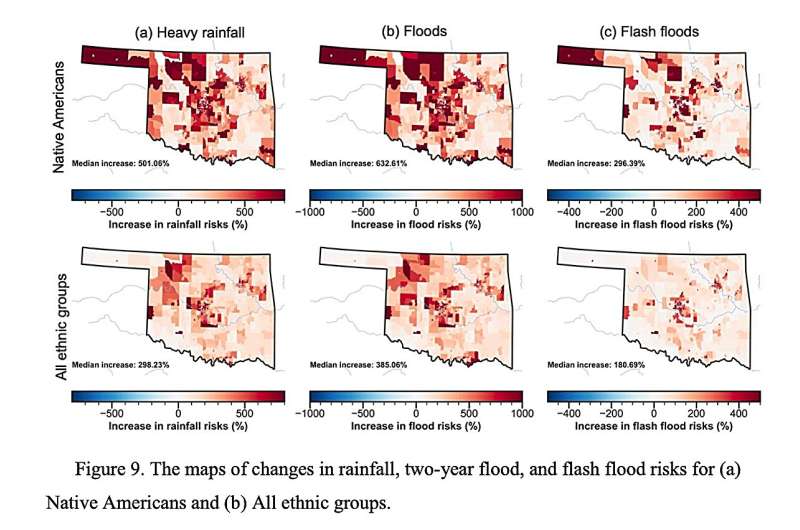This article has been reviewed according to Science X's editorial process and policies. Editors have highlighted the following attributes while ensuring the content's credibility:
fact-checked
trusted source
proofread
Severe weather disproportionately impacts Oklahoma's native communities, study shows

As the climate, demographics and land usage continue to change, tribal communities in Oklahoma are increasingly at risk of severe weather. A recent study led by Yang Hong with the University of Oklahoma examines these changes and the risks they pose.
"Indigenous communities are grappling with an imminent climate crisis compounded by systemic injustices. Recognizing their unique connections to their homelands as sovereign peoples is crucial in addressing these pressing issues," Hong said.
Hong is the corresponding author of the paper, "Future heavy rainfall and flood risks for Native America under climate and demographic changes: A case study in Oklahoma," recently published in the American Meteorological Society's Weather, Climate, and Society journal. He is a hydro-meteorology-climatology and remote sensing professor in the School of Civil Engineering and Environmental Sciences and the School of Meteorology, and director of the Hydrometeorology and Remote Sensing Laboratory at the National Weather Center.
He says making climate-related risk assessments and recommendations for Native lands has traditionally been difficult due to a lack of usable information. However, by coupling regional climate models and flash flood forecasting models, this study offers research for three climate hazards for Native Nations in Oklahoma: heavy rainfall, two-year floods and flash floods.
According to the research, heavy rainfall is projected to have a 501.1% increased risk for Native Americans by the end of the century—68% higher than the general population in Oklahoma. Two-year floods are projected to have a 632.6% increased risk, and flash floods are projected to have a 296.4% increased risk—64.3% and 64% higher than the general population in Oklahoma, respectively.
Researchers believe this study can help project future climate extremes in Oklahoma and help evaluate the impacts of climate change and the increased risk to tribal populations. They also believe this research can help Native American leaders develop disaster risk reduction plans.
"Bringing attention to the risks and experiences Native Americans face with flooding and extreme weather can foster collaboration among Indigenous peoples, diverse communities, and scholars across the sciences and humanities," said Farina King, co-author, an associate professor of Native American Studies and the Horizon Endowed Chair of Native American Ecology and Culture. "We must all work together to overcome the challenges to protect our most vulnerable communities and Indigenous peoples who sustain precious ecological knowledge."
The paper is published in the journal Weather, Climate, and Society.
More information: Zhi Li et al, Future Heavy rainfall and flood risks for Native America under climate and demographic changes: A case study in Oklahoma, Weather, Climate, and Society (2023). DOI: 10.1175/WCAS-D-23-0005.1
Provided by University of Oklahoma




















